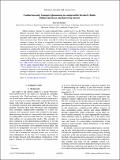| dc.description.abstract | “Diffuse interface” theories for single-component fluids—dating back to van der Waals, Korteweg, Cahn-Hilliard, and many others—are currently based upon an ad hoc combination of thermodynamic principles (built largely upon Helmholtz's free-energy potential) and so-called “nonclassical” continuum-thermomechanical principles (built largely upon Newtonian mechanics), with the latter originating with the pioneering work of Dunn and Serrin [Arch. Ration. Mech. Anal. 88, 95 (1985)]. By introducing into the equation governing the transport of energy the notion of an interstitial work-flux contribution, above and beyond the usual Fourier heat-flux contribution, namely, j[subscript q] = −k∇T, to the energy flux, Dunn and Serrin provided a rational continuum-thermomechanical basis for the presence of Korteweg stresses in the equation governing the transport of linear momentum in compressible fluids. Nevertheless, by their failing to recognize the existence and fundamental need for an independent volume transport equation [Brenner, Physica A 349, 11 (2005)]—especially for the roles played therein by the diffuse volume flux j[subscript v] and the rate of production of volume π[subscript v] at a point of the fluid continuum—we argue that diffuse interface theories for fluids stand today as being both ad hoc and incomplete owing to their failure to recognize the need for an independent volume transport equation for the case of compressible fluids. In contrast, we point out that bivelocity hydrodynamics, as it already exists [Brenner, Phys. Rev. E 86, 016307 (2012)], provides a rational, non-ad hoc, and comprehensive theory of diffuse interfaces, not only for single-component fluids, but also for certain classes of crystalline solids [Danielewski and Wierzba, J. Phase Equilib. Diffus. 26, 573 (2005)]. Furthermore, we provide not only what we believe to be the correct constitutive equation for the Korteweg stress in the class of fluids that are constitutively Newtonian in their rheological response to imposed stresses but, equally importantly, we establish the explicit functional forms of Korteweg's phenomenological thermocapillary coefficients appearing therein. | en_US |
